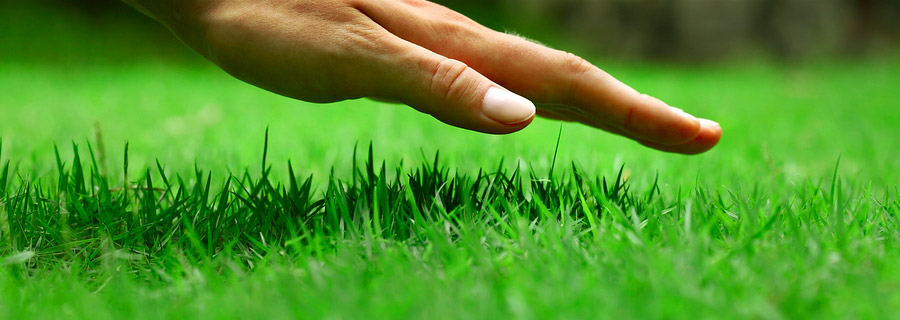
Guide to Caring For Your New Lawn Ireland
Mowing Your New Lawn
The turf should have established (i.e. rooted into the ground) within 2 weeks during mild growing weather, providing it has received sufficient watering. It will be slower during winter months due to the lower soil temperature. Once you are happy that the turf has established sufficiently, and ALWAYS BEFORE THE GRASS GETS TWO INCHES HIGH, mowing can commence. Adjust your mower to a high setting so that ONLY THE TIPS of the grass leaves are removed at first. If mowing is too severe it can inhibit establishment of the roots and even kill the grass.
If you have not levelled the site adequately, or if it has settled due to insufficient consolidation, the mowing may leave brown areas where the grass has been cut too short. This is one of the most common faults with new lawns. You should raise the height of the mower for subsequent mowings, and meanwhile correct the levels by rolling lightly and/or top-dress the depressions with soil.
Mowing the Established Lawn
Mowing should be done regularly as required, depending on growing conditions, and at least once per week from spring to autumn. Avoid leaving the lawn unmown for any number of weeks. If the height of cut is to be reduced, it can be gradually reduced over a number of weeks during the main growing season, but NEVER TAKE MORE THAN 25% of the initial height of the grass in one cut, and never mow the grass closer than ½ inch. During the winter, if mild conditions prevail, mow whenever frost is not imminent.
Fertilising the New Lawn
Nitrogen, one of any plants’ essential nutrients for lush leaf development, leaches / washes out from the topsoil extremely quickly. Therefore in a wet climate such as Ireland’s, it is essential to replenish with a suitable fertilizer on a regular basis. This should be carried out every 4 – 6 weeks during the growing season, as nitrogen applied late in the autumn or winter will cause lush leaf development which could be scorched by frost at this time of the year.
Feeding the Established Lawns
This is the single most important factor which leads to the quality of the lawn deteriorating. Lawns, like all living organisms require regular feeding if they are to remain in a healthy condition. If they are not fed regularly, the grass plants will loose colour, thin out and cannot compete with weeds and moss.
All established lawns should be fed in the spring at the first real signs of any growth. This enables the lawn to start the season off with good vigorous, healthy growth, ahead of any germinating weeds. A spring / summer lawn feed is available from most garden centres, and it should be applied as stated on the product label. The same feed should be applied regularly throughout the growing season, normally every 4-6 weeks, with the last spring / summer feed before the end of August.
To maintain a healthy state and a good colour throughout the winter period, it is essential the lawn is given an autumn / winter feed. Again this is available from most garden centres, and it should be applied as stated on the product label.
Rolling
Occasionally the lawn will require a light rolling in the spring, because of “frost lift” during the cold winter months. This should only be done when the surface of the lawn is in a dry condition, otherwise it can cap the surface and impede drainage.
Weeding
It is inevitable that broad leaved weeds appear from time to time, spreading from other parts of the garden or from further afield. If the problem in only slight, the weeds can be removed by hand, as and when they appear. However if the problem necessitates, a selective broad leaf weed killer for lawns can be obtained from any garden centre, and it should be applied as stated on the product label.
Coarse grass weeds can invade to a certain extent, depending on the level of maintenance applied. Unfortunately selective weed killer is not an option in these circumstances. It is advisable to remove these weeds by hand as and when they appear, or they might quickly spread throughout the lawn, causing an unsightly problem.
Moss Control
Moss will develop in a lawn only if the grass is too weak to compete with it. The reason for the weakening of the grass may be waterlogged and / or compacted soil, mowing too close and / or infrequently, inadequate feeding or stress due to very dry conditions. The cause should be identified and corrected before the problem becomes severe. For short-term control various chemical treatments are available from any Garden Centre and should be applied as stated on the product label. Moss will re-invade if the grass is not invigorated by corrective action taken against the problem or problems stated earlier.
Scarifying or “Thatch Removal”
Periodically the brown fibrous “thatch” layer, which develops between the soil and the grass shoots, should be removed.
This can be done using a spring-tined rake or a mechanical lawn scarifier / moss raker if the area is large. Only carry out this procedure when the grass is growing actively and don’t be alarmed by the resultant thin sward. The lawn will take on a new lease of life and should develop a thick sward within 2-3 weeks if good growing conditions prevail.
Aerating
A garden fork or mechanical lawn spiker will relieve compaction and help surface water to drain more easily. It also allows more air to reach the grass roots and consequently aid healthy growth. This operation should normally be carried out late in the summer. On very heavy clay soils a “Hollow Tining” tool may be used to remove cores of soil and a sandy top dressing should then be applied and worked well into the holes. This will create a lighter soil texture which allows surface water to drain more easily and more air to reach the grass roots, creating healthier growth.
Worms and Pest Control
Worm casts can scar the surface of the lawn leading to an unsightly mess. In addition certain types of grubs or slugs can cause severe damage to newly laid lawns by eating the newly emerging grass roots. Normally birds feeding on these pests during the autumn / winter periods will be a sign of a potential problem. Identify the exact pest present and then a suitable worm killer / insecticide should be obtained from any garden centre, and applied as stated on the product label.
Disease Control
Normally only two types of disease are ever likely to attack your lawn. “Red Thread” disease creates bleached or pinkish patches on the lawn surface which can spread to encompass the entire area if left untreated. Sometimes bright red ‘needles’ are also formed at the tips of the leaf blades. Red Thread can attack all types of grass species and its often linked to low soil fertility. Therefore a proper lawn feed will normally correct the problem, however this remedy should only be attempted before the end of August. From September onwards, a fungicide recommended for lawn diseases should be obtained from any Garden centre, and applied as stated on the product label.
“Fusarium Patch” Disease, which will only normally appear in the 2nd half of the year, causes the leaf blades to collapse and yellowish-brown patches appear on the lawn. Fusarium Patch tends to occur when the air is mild, still and damp. Often this disease is caused by overfeeding the lawn, with a spring / summer feed, too late in the year. This disease is only normally apparent in the fine lawn grass species and can cause severe damage if it is not treated immediately upon diagnosis. A fungicide recommended for lawn disease should be obtained from any garden centre, and applied as stated on the product label.
Small brown toadstools often appear during the summer in the first year the lawn is laid. This is due to the good growing conditions combined with high fertility created prior to laying the new lawn. They are not damaging to the lawn and will die out relatively quickly of their own accord.
Ready to upgrade your lawn?
If you are ready to upgrade your lawn, Emerald Lawns are ready to help you. We are the leading supplier of turf-grass in Ireland, so you know you are in good hands.
Order Your Turf Now!